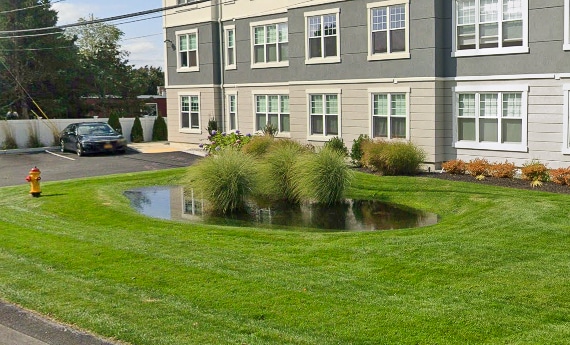If you’re seeking eco-friendly, effective and gorgeous methods of boosting your home’s waterproofing, a rain garden may be the solution. Harnessing the power of native plants comes with all kinds of benefits and it’s a lot more interesting to look at than yet another lawn.
What is a Rain Garden?
A rain garden is an area of your garden containing native shrubs, flowers and perennials, in a small depression. They’re usually located on a natural slope and are designed to temporarily hold and absorb rainwater and runoff.
Unlike ponds and wetland gardens, a rain garden has the benefit of absorbing rainwater without becoming permanently sodden. They usually manage to absorb any rainfall or runoff within 12-48 hours, meaning they don’t provide a habitat for mosquitos.
Overall, they’re a great solution to dealing with what could otherwise be a really troublesome problem. They also have the added benefits of looking great and providing a habitat for various species, boosting local biodiversity.
The History of Rain Gardens
Rain gardens were formally developed in around 1990 in Maryland, though they build on a concept as old as time.
In nature plants and the soil absorb most rainwater, including the various nutrients and contaminates it contains. Unfortunately, as more and more land was given over to agriculture and lawns, neither of which tends to be hugely absorbent, this lead to degradation of our waterways and an increase in the level of flooding during stormy weather.
Rain gardens solve this issue by combining native plants, which are well suited to the environment, and a small depression, set into a slope. This creates a natural funnel and sponge to direct and absorb water from roofs, driveways, patios and storm water.
Components of A Rain Garden
Rain gardens are remarkably simple in terms of construction. They consist of four elements:
Native Plants
Native plants are the best choice here. Not only will they look great, they’re adapted to the local environment and provide the best habitat for native wildlife too. Another benefit to choosing native species: they don’t require fertilizer. This means that there are less chemicals and contaminates entering the water table, and less maintenance for you too.
Soil
Depending on conditions you have on your property, it may be necessary to bring in absorbent soils. Ideally, you want a rain garden to be fairly loamy: able to retain water, but not become permanently sodden. You’re looking for an infiltration rate of about half an inch per hour.
Mulch
Mulch comes in lots of different varieties, but the most common are bark chips and leaf litter. A good thick layer around your native plants has a few benefits. Firstly, it protects your plants from slugs, snails and other pests. A good mulch layer also helps the soil to retain water around the roots, which is important when establishing your rain garden or during drier spells. Mulch also acts as a ‘first line of defense’ for filtering out contaminates from rainwater too.
Inlet
For a rain garden to work as a receptacle for rainwater and runoff, you’ll need some way to get the water to the depression. Ideally, you want one or two downspouts directing the flow of water into your hollow.
Benefits of A Rain Garden
As we’ve already mentioned, rain gardens have ecological, aesthetic and financial benefits.
Ecological Benefits
Perhaps the best thing about rain gardens is their use of natural, native plants to deal with problems. Firstly, they provide a natural solution to storm water runoff, allowing the water to be used rather than overwhelming local streams and rivers. Secondly, they provide a great level of filtration, removing chemicals and contaminates that would otherwise enter the water table.
On top of these benefits of a rain garden, they also encourage local wildlife into your garden. Picking native plants means that there’s food and shelter for bees, birds, butterflies and more. At the same time, the lack of permanent stagnant water means that there are no mosquitos.
Storm Water Runoff
One of the most practical benefits of a rain garden is its ability to prevent pooling water. Pooling water can be a significant issue in gardens and around homes, leading to water damage, erosion, and providing a breeding ground for mosquitoes. Rain gardens are designed to absorb and manage rainwater runoff effectively. By capturing and holding rainwater temporarily, a rain garden allows the water to slowly infiltrate into the ground rather than accumulating in low-lying areas. This not only prevents unsightly and potentially damaging pools of water but also helps to recharge the groundwater supply. Additionally, by directing water away from your home’s foundation, rain gardens can reduce the risk of basement flooding and soil erosion around your property.
Aesthetic Benefits
Of course, a garden should be a place of beauty and rain gardens are no exception. While you should aim for native plants, that’s really not much of a restriction in the looks department. With a baffling selection of shrubs, flowers and perennials to choose from, you can shape it to your tastes.
One group of plants to avoid: trees. Trees generally absorb more water than other plants, so they could out-compete your carefully selected shrubs.
Economic Benefits
Rain gardens come with two major economic benefits:
- They’re cheap to install in comparison to other storm water management systems
- They can seriously increase your home’s value
How Rain Gardens Work
Rain gardens are a remarkably simple solution to the problem of storm water and runoff.
The shallow depression fills with water which then infiltrates through the mulch and soil over the course of around two days. As it does so, the carefully selected plants filter out toxins, pollutants and bacteria, meaning what does enter the water table is much cleaner.
The process by which this happens is known as infiltration. As the water builds up in the depression, it slowly works its way through the mulch, into the soil, where it’s retained until the plants can absorb it.
By carefully selecting your plants and their location, you can increase the effectiveness as both a receptacle and filter. Opt for more drought-resistant species around the edges and ones which enjoy damper conditions in the center. By sticking to native plants, you gain the advantages of avoiding chemical pesticides, fertilizers and boosting local biodiversity. Loamy soil (whether natural or achieved through tillage) and mulch will help your rain garden weather dry spells too.
Steps For Creating A Rain Garden
Gaining all the benefits of a rain garden isn’t a huge task in terms of waterproofing efforts. Follow the simple steps below, or consult a professional and you could be planting in no time.
Site Selection
First things first, you want to pick the best possible site. There are a few factors to consider here:
- Access to runoff: rain gardens are great for dealing with runoff from impermeable surfaces like sidewalks and roofs. You’ll need to consider how the water will get from there to the roots of your plants.
- Slope: Water runs downhill, so placing your depression on a slope makes sense.
- Keep away from Basements: you want water in your garden, not your basement. Leave at least 10 feet between your property wall and your rain garden. Likewise, if you have a septic tank, put the garden elsewhere.
You’ll also want to consider what the natural ground is like in your chosen location. Is it sandy, loamy or clay based soil? Is there a natural indentation in the landscape you could use? All of these factors can be altered during installation, but why work harder?
Design
Once you’ve chosen a location, it’s time to start doing some designing. This includes steps like picking your ideal plants and sketching out what you want the end result to look like, but also involves some basic math.
You want your rain garden to have an infiltration rate of about a ½ inch per hour. This may require tilling your soil, or you may get lucky and find you already meet this criteria. You also want your garden to cover at least 20% of the area that it’ll be fed by the run off from. This means that if it’s collecting water from a downspout, you want it to be about a quarter the size of that side of your roof.
Installation
Installing and planting a rain garden is a fairly straightforward process:
- Mark out your area using rope
- Remove about 6-8 inches of soil
- Add any amendments to your soil
- Plant your plants: drought-resistant types to the outside edge
- Add mulch
Most people can complete an average sized rain garden in a day, though it can be quite laborious. Rope in friends and family to help with the work or consult a professional.
Maintenance
Maintaining a rain garden isn’t much different to maintaining any other planted area. Remove weeds and dead plants and, if there’s a dry spell, consider watering as necessary. Over time, as your plants become established, there’s less need for weeding as they will outcompete the interlopers.
Rain Gardens and Basement Waterproofing
Not only are rain gardens a beautiful and simple solution to dealing with runoff and contaminates, they’re great for your basement waterproofing problems too. By supplying a place for water to be ‘stored’ away from your walls and easy paths into it, that rain water is diverted away from your basement.
They also provide a great place to end a French drain, guttering system or discharge a sump-pump. Rather than creating a swampy, mosquito-ridden area, a rain garden puts that discharge to work beautifying your property in the process.
As with any waterproofing efforts, consulting a professional is always a good idea. They’ll be able to help you make any decisions and be able to advise about any potential issues. They’ll also be able to save your back by helping with the digging too.
Rain gardens come with a number of benefits, ecological, aesthetic and economic. If you’re lucky enough to have a suitable garden, they’re an enjoyable project that repays your efforts in beautiful native plants, fascinating wildlife and dry basements.

